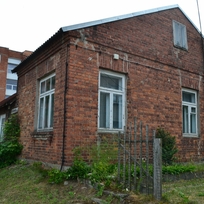Memorial stones are commemorative plaques installed on sidewalks or street pavements to commemorate the victims of National Socialism. These stones are placed near former homes, educational institutions or workplaces, reminding us that specific people who built local communities suffered or died during the Holocaust.
Currently, almost 70,000 such memorial markers are installed, and together they form the world's largest open-air memorial museum.
Hiršas Kalmanavičius was born in 1887. In Alytus, he studied at a Jewish primary school. Later, he went to Vilnius to continue his education at the "Religious Studies" school, where he completed the 4th department. This school taught special religious and general science subjects that corresponded to 4 high school classes. During the First World War, like most of the Jews of the border provinces, he was deported to the depths of Russia by order of the tsar.
in 1921 Hiršas Kalmanavičius returned to Alytus, the same year, on September 30, he was issued a passport of the Republic of Lithuania. Since the return to 1940 Hirš worked at the Alytus Jewish High School. Later, this school was named Alytus Jewish private pro-gymnasium. His subjects were geography, history, Hebrew and religion (Jewish). The school changed its address several times, not all of them are known, but when 1922 Hiršas Kalmanavičius started teaching there, the school was located on Užuolanka street. 22 (now Užuolanka st. 30).
in 1941 When the Nazis occupied Alytus, almost all the Jews of the city suffered without exception, including Hiršas Kalmanavičius. Due to the lack of archival documents, it is impossible to reconstruct the last days of H. Kalmanavičius's life, but knowing that, about 4-5 per cent of them lived to the end of the war. Lithuanian Jews, it can be said that Hiršas Kalmanavičius was killed together with the entire town community.
Photos from the Alytus TIC archive




Reviews